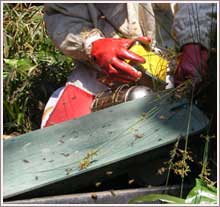Bees in
Watermeters 
We were called out to investigate a swarm of bees who decided that
the water meter in someone's backyard was the perfect place to build
a home. The proximity of water is always a draw card for bees, and a
water meter is usually, dark quiet and cool. An a bonus is that once
the bees are in, they are out of sight and safe from most natural predators.
The give away is that bees need to forage, both to keep the existing
colony strong and also to make sure that the new additions to colony
are well fed and strong.
After spotting the bees coming and going from the water meter, we opened
the lid slightly and used smoke
to calm the bees. Smoke generally has a sedative effect on bees, but
that doesn't mean you can disregard your protective clothing.
Once the bees were in a more sedate state, we transferred them into
a transport hive, along with the queen, and removed as much of the honey
and honeycomb as possible. The remnants might attract robber bees, but
this is usually not a problem, the might hang around for a day or two,
removing the honey and honeycomb that was left behind.
We then take the bees and re-hive them and once they are settled in
their new home they are sent to a farm where they can get on with the
business of pollinating and doing what bees do.
 
Why do bees build their hive in our watermeter?
That water is necessary for survival is the same for bees as it is for any other living creature. So finding a beehive in your water meter or irrigation system is not a rarity at all.
When the daily temperature is high, bees will quite likely need more water. Bees are assigned tasks as soon as they hatch from the cells they were laid in. Often the tasks they are assigned are for life. They will either forage for food or tend to the young. Some will keep the hive clean or build new cells so that the queen can keep layng eggs. A few select bees will spend their lives tending to the queen.
During the hot months bees will use the water to cool the hive by spreading it along the surface of the sealed cells and around the edges of the cells which are not capped and then set up a fanning of the wings that will cause the air in the hive to circulate cooling it down.
The water collected also allows the bees that are nursing the larvae to produce the jelly that is required to feed their charges.
As honey dries it may crystalise, the water is used to dissolve these crystals before the bees can feed on it.
So with all this it seems that bees need water just as much as you and I do, which explains why you occasionally find them building their hives in places like a watermeter or an irrigation system. Occasionally there will be a leak allowing the bees to have access to the water.
The bees will keep to themselves but they may cause a jam in the workings of the system with wax or dripping honey. It is best to have the removed and relocated by a professional.
last updated 10 February 2015 |

